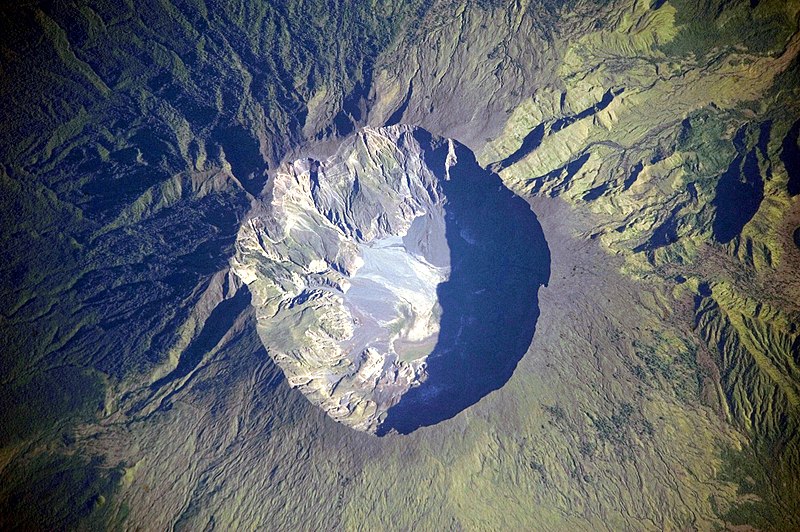Datei:Mount Tambora Volcano, Sumbawa Island, Indonesia.jpg

Originaldatei (4.256 × 2.828 Pixel, Dateigröße: 2,29 MB, MIME-Typ: image/jpeg)
Diese Datei stammt aus Wikimedia Commons und kann von anderen Projekten verwendet werden. Die Beschreibung von deren Dateibeschreibungsseite wird unten angezeigt.
Beschreibung
| BeschreibungMount Tambora Volcano, Sumbawa Island, Indonesia.jpg |
Bahasa Indonesia: Foto astronot ini menggambarkan kaldera puncak gunung Tambora. Kaldera ini berdiameter 6 km dan terbentuk dengan dalam 1.100 m ketika puncak Gunung Tambora yang berketinggian kira-kira 4.000 m telah tidak ada, dan ruangan magma di bawahnya menjadi kosong setelah letusan tahun 1815. Saat ini dasar kawah menjadi lokasi sebuah danau air tawar musiman, deposit sedimen yang belum lama, aliran lava kecil, dan kubah yang terbentuk selama abad kesembilan belas dan kedua puluh. Deposit tephra yang berlapis terlihat di sepanjang sisi barat laut bibir kawah. Fumarol aktif, atau ventilasi uap, masih ada di kaldera.
English: This detailed astronaut photograph depicts the summit caldera of the volcano. The huge caldera—6 kilometers in diameter and 1,100 meters deep—formed when Tambora’s estimated 4,000-meter-high peak was removed, and the magma chamber below emptied during the 1815 eruption. Today the crater floor is occupied by an ephemeral freshwater lake, recent sedimentary deposits, and minor lava flows and domes emplaced during the nineteenth and twentieth centuries. Layered tephra deposits are visible along the north-western crater rim. Active fumaroles, or steam vents, still exist in the caldera.
Français : Photographie de la caldera sommitale du mont Tambora, en Indonésie. Cette caldera est immense, avec 6 km de diamètre et 1000 m de profondeur. Sa formation date de l'éruption de 1815, qui est l'éruption volcanique la plus importante de l'histoire. Avant l'éruption, le Tambora formait un pic d'une altitude d'environ 4000 m. Aujourd'hui, les lèvres de la caldera sont à 2500 m d'altitude. Le fond de la caldera est occupé par un lac temporaire, des coulées de laves provenant d'éruptions mineures et des fumeroles.
Deutsch: Krater des Tambora
Русский: Эта фотография подробно показывает кальдеру вулкана Тамбора, имеющую 6 — 7 километров в диаметре. Она образовалась в результате катастрофического извержения 1815 года, когда верхняя часть вулкана обрушилась из-за опустения магматической камеры под ним. Сегодня внутри кальдеры находится небольшое пресноводное озеро, лавовые купола, а в северо-западной части кратера имеются многослойные отложения тефры. Кроме того кальдере присуща фумарольная активность.
|
||||||||||||||||||||||||||||||||||||||||||||||||||||||
| Datum | Published 2009-07-19. Taken 2009-03-06. | ||||||||||||||||||||||||||||||||||||||||||||||||||||||
| Quelle | Image and and English description: Mount Tambora Volcano, Sumbawa Island, Indonesia, NASA Earth Observatory. 2nd version: Übertragen aus de.wikipedia nach Commons.; originally from https://eol.jsc.nasa.gov/SearchPhotos/photo.pl?mission=ISS020&roll=E&frame=06563 | ||||||||||||||||||||||||||||||||||||||||||||||||||||||
| Urheber | This image was taken by the NASA Expedition 20 crew. | ||||||||||||||||||||||||||||||||||||||||||||||||||||||
| Kameraposition | 8° 14′ 34,4″ S, 117° 59′ 45,2″ O | Dieses und weitere Bilder auf OpenStreetMap |
|---|
Diese Mediendatei wurde vom Johnson Space Center der US-amerikanischen National Aeronautics and Space Administration (NASA) unter der Datei-ID ISS020-E-6563 kategorisiert. Diese Markierung zeigt nicht den Urheberrechtsstatus des zugehörigen Werks an. Es ist in jedem Falle zusätzlich eine normale Lizenzvorlage erforderlich. Siehe Commons:Lizenzen für weitere Informationen. Sprachen:
العربية ∙ беларуская (тарашкевіца) ∙ български ∙ català ∙ čeština ∙ dansk ∙ Deutsch ∙ English ∙ español ∙ فارسی ∙ français ∙ galego ∙ magyar ∙ հայերեն ∙ Bahasa Indonesia ∙ italiano ∙ 日本語 ∙ македонски ∙ മലയാളം ∙ Nederlands ∙ polski ∙ português ∙ русский ∙ sicilianu ∙ slovenščina ∙ Türkçe ∙ українська ∙ 简体中文 ∙ 繁體中文 ∙ +/− |
|
Lizenz
| Public domainPublic domainfalsefalse |
| Diese Datei ist gemeinfrei (public domain), da sie von der NASA erstellt worden ist. Die NASA-Urheberrechtsrichtlinie besagt, dass „NASA-Material nicht durch Urheberrecht geschützt ist, wenn es nicht anders angegeben ist“. (NASA-Urheberrechtsrichtlinie-Seite oder JPL Image Use Policy). |  | |
 |
Warnung:
|
Original upload log (2nd version)
- 2009-07-23 01:35 Geoethno 1440×960× (469914 bytes) {{Information |Beschreibung = Krater des Tambora |Quelle = http://earthobservatory.nasa.gov/images/imagerecords/39000/39412/ISS020-E-06563_l
Kurzbeschreibungen
In dieser Datei abgebildete Objekte
Motiv
8°14'34.400"S, 117°59'45.200"E
ISS020-E-6563
0,0004 Sekunde
5,6
800 Millimeter
200
image/jpeg
Dateiversionen
Klicke auf einen Zeitpunkt, um diese Version zu laden.
| Version vom | Vorschaubild | Maße | Benutzer | Kommentar | |
|---|---|---|---|---|---|
| aktuell | 14:55, 24. Feb. 2011 |  | 4.256 × 2.828 (2,29 MB) | wikimediacommons>Originalwana | higher res |
Dateiverwendung
Die folgende Seite verwendet diese Datei:
Metadaten
Diese Datei enthält weitere Informationen, die in der Regel von der Digitalkamera oder dem verwendeten Scanner stammen. Durch nachträgliche Bearbeitung der Originaldatei können einige Details verändert worden sein.
| Hersteller | NIKON CORPORATION |
|---|---|
| Modell | NIKON D3 |
| Belichtungsdauer | 1/2.500 Sekunden (0,0004) |
| Blende | f/5,6 |
| Film- oder Sensorempfindlichkeit (ISO) | 200 |
| Erfassungszeitpunkt | 00:08, 3. Jun. 2009 |
| Brennweite | 800 mm |
| Kameraausrichtung | Normal |
| Horizontale Auflösung | 240 dpi |
| Vertikale Auflösung | 240 dpi |
| Software | Microsoft Windows Photo Gallery 6.0.6001.18000 |
| Speicherzeitpunkt | 12:54, 24. Feb. 2011 |
| Belichtungsprogramm | Blendenautomatik |
| Exif-Version | 2.21 |
| Digitalisierungszeitpunkt | 00:08, 3. Jun. 2009 |
| APEX-Belichtungszeitwert | 11,287712 |
| APEX-Blendenwert | 4,970854 |
| Größte Blende | 5 APEX (f/5,66) |
| Messverfahren | Spotmessung |
| Lichtquelle | Unbekannt |
| Blitz | kein Blitz |
| Speicherzeitpunkt (1/100 s) | 00 |
| Erfassungszeitpunkt (1/100 s) | 00 |
| Digitalisierungszeitpunkt (1/100 s) | 00 |
| Farbraum | sRGB |
| Messmethode | Ein-Chip-Farbsensor |
| Benutzerdefinierte Bildverarbeitung | Standard |
| Belichtungsmodus | Automatische Belichtung |
| Weißabgleich | Automatisch |
| Digitalzoom | 1 |
| Brennweite (Kleinbildäquivalent) | 800 mm |
| Aufnahmeart | Standard |
| Kontrast | Normal |
| Sättigung | Normal |
| Schärfe | Normal |
| Motiventfernung | Unbekannt |
